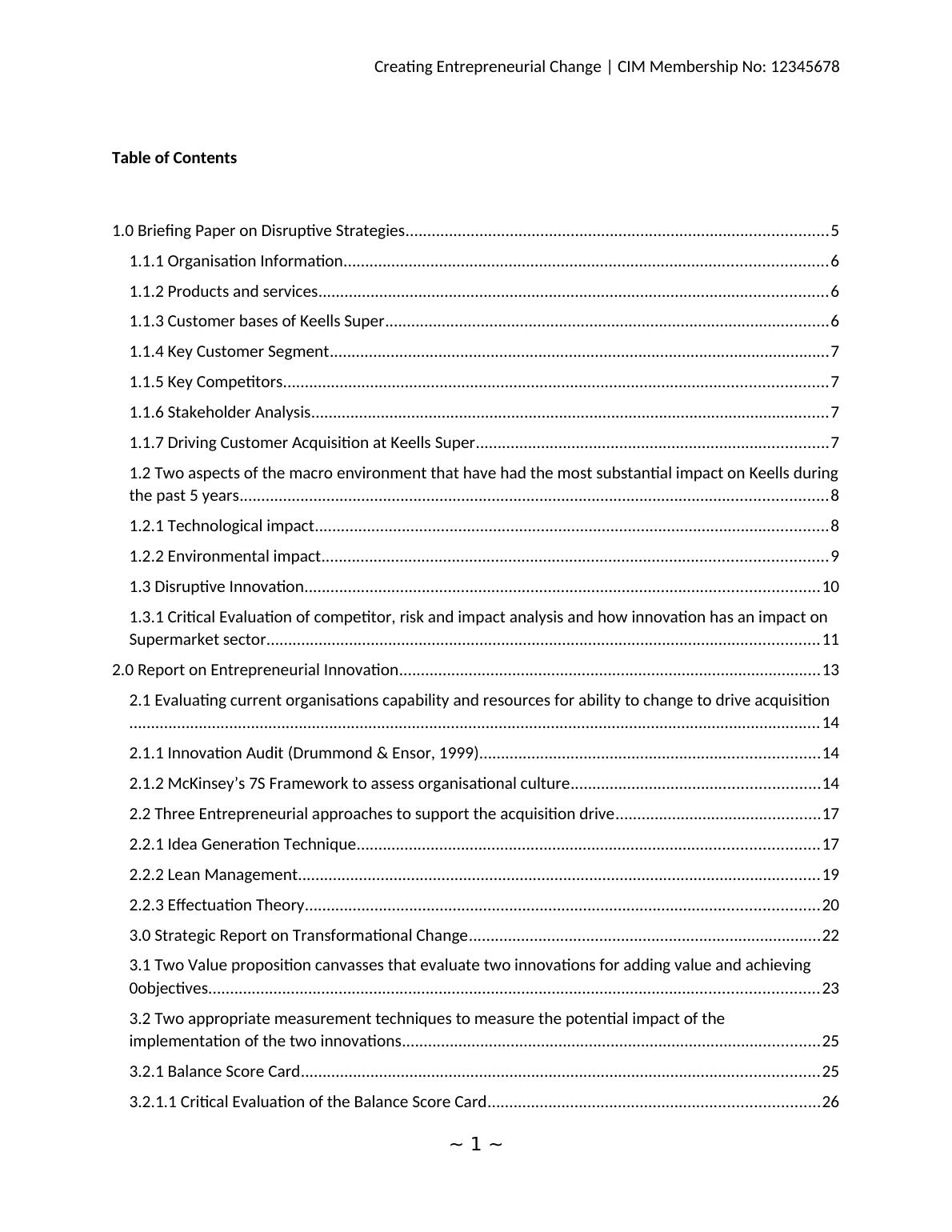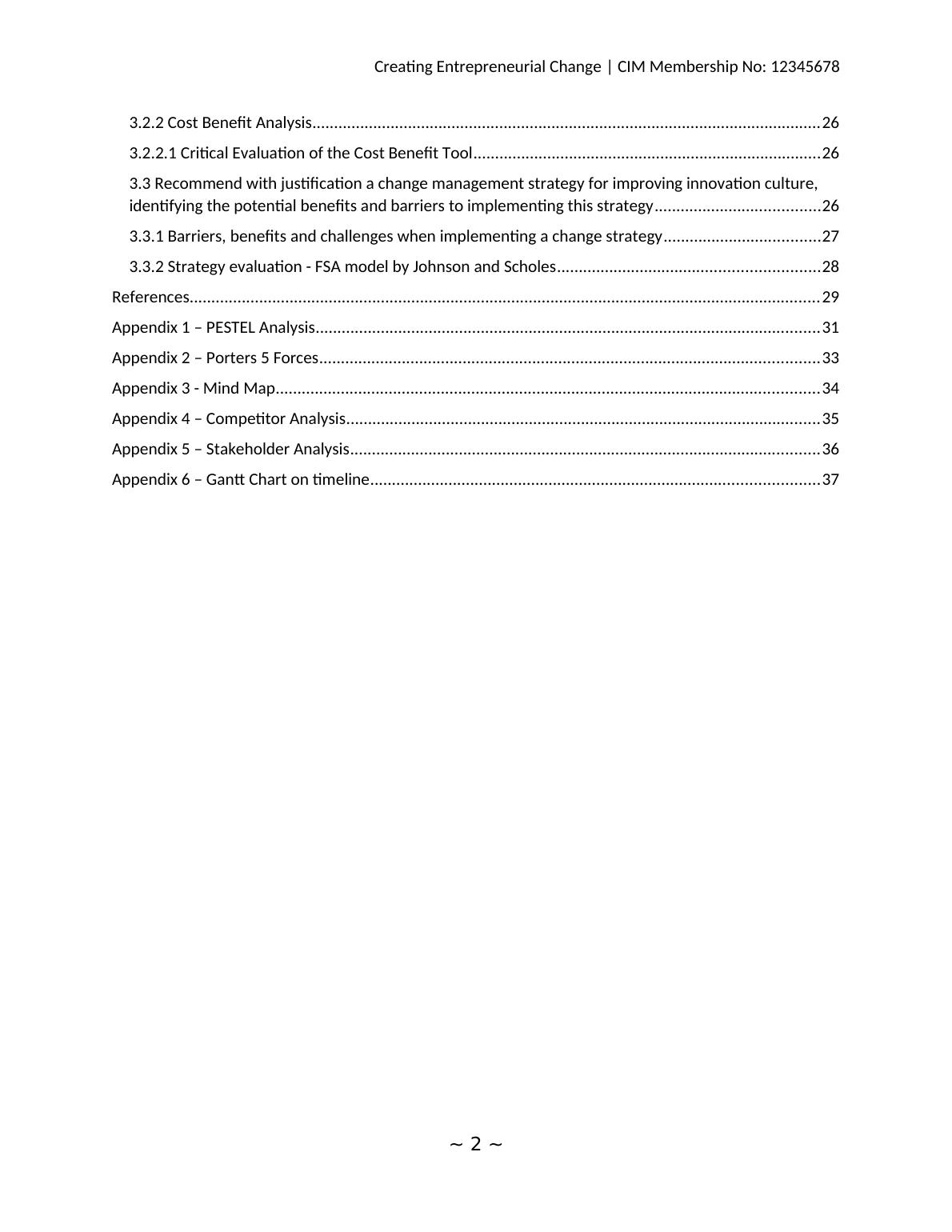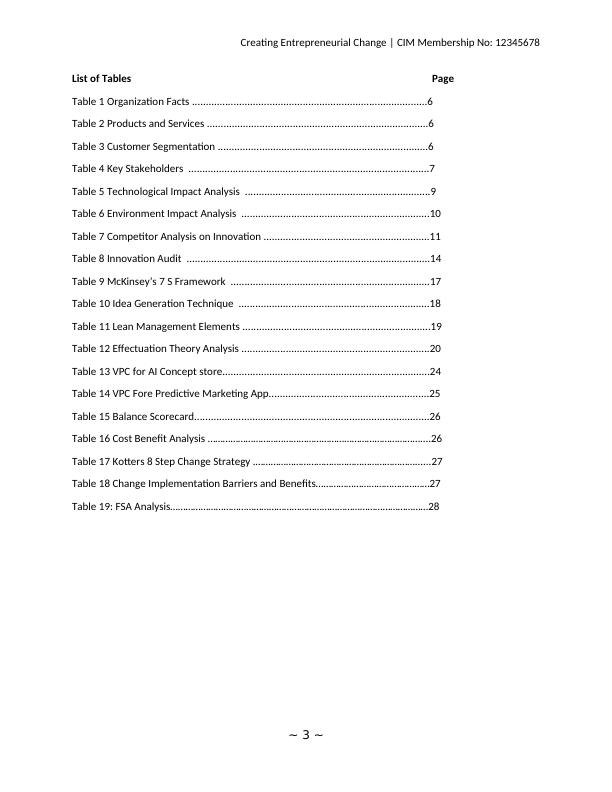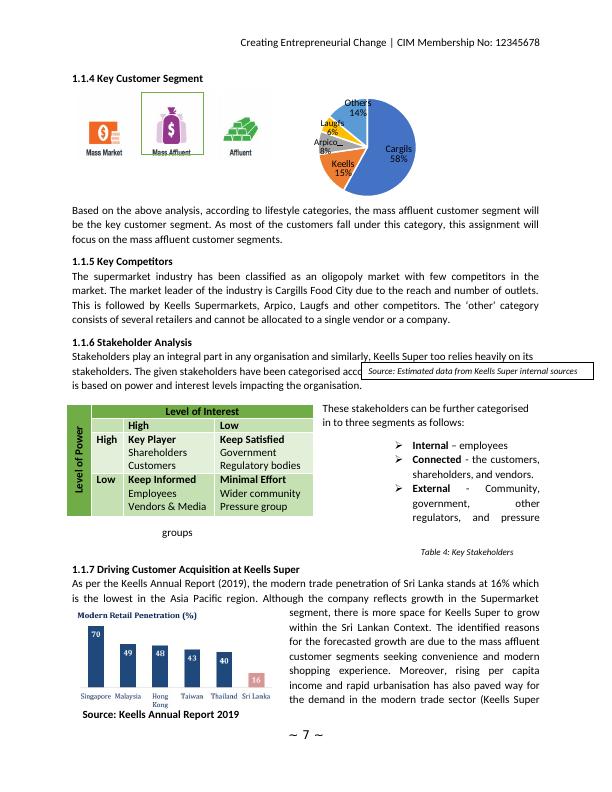Creating Entrepreneurial Change PDF
39 Pages9630 Words109 Views
Added on 2021-10-11
Creating Entrepreneurial Change PDF
Added on 2021-10-11
ShareRelated Documents
CREATING ENTREPRENEURIAL CHANGE
March 2020
CIM Membership No: 11122233

Creating Entrepreneurial Change | CIM Membership No: 12345678
Table of Contents
1.0 Briefing Paper on Disruptive Strategies.................................................................................................5
1.1.1 Organisation Information...............................................................................................................6
1.1.2 Products and services.....................................................................................................................6
1.1.3 Customer bases of Keells Super......................................................................................................6
1.1.4 Key Customer Segment...................................................................................................................7
1.1.5 Key Competitors.............................................................................................................................7
1.1.6 Stakeholder Analysis.......................................................................................................................7
1.1.7 Driving Customer Acquisition at Keells Super.................................................................................7
1.2 Two aspects of the macro environment that have had the most substantial impact on Keells during
the past 5 years.......................................................................................................................................8
1.2.1 Technological impact......................................................................................................................8
1.2.2 Environmental impact....................................................................................................................9
1.3 Disruptive Innovation......................................................................................................................10
1.3.1 Critical Evaluation of competitor, risk and impact analysis and how innovation has an impact on
Supermarket sector...............................................................................................................................11
2.0 Report on Entrepreneurial Innovation.................................................................................................13
2.1 Evaluating current organisations capability and resources for ability to change to drive acquisition
...............................................................................................................................................................14
2.1.1 Innovation Audit (Drummond & Ensor, 1999)..............................................................................14
2.1.2 McKinsey’s 7S Framework to assess organisational culture.........................................................14
2.2 Three Entrepreneurial approaches to support the acquisition drive...............................................17
2.2.1 Idea Generation Technique..........................................................................................................17
2.2.2 Lean Management........................................................................................................................19
2.2.3 Effectuation Theory......................................................................................................................20
3.0 Strategic Report on Transformational Change.................................................................................22
3.1 Two Value proposition canvasses that evaluate two innovations for adding value and achieving
0objectives............................................................................................................................................23
3.2 Two appropriate measurement techniques to measure the potential impact of the
implementation of the two innovations................................................................................................25
3.2.1 Balance Score Card.......................................................................................................................25
3.2.1.1 Critical Evaluation of the Balance Score Card............................................................................26
~ 1 ~
Table of Contents
1.0 Briefing Paper on Disruptive Strategies.................................................................................................5
1.1.1 Organisation Information...............................................................................................................6
1.1.2 Products and services.....................................................................................................................6
1.1.3 Customer bases of Keells Super......................................................................................................6
1.1.4 Key Customer Segment...................................................................................................................7
1.1.5 Key Competitors.............................................................................................................................7
1.1.6 Stakeholder Analysis.......................................................................................................................7
1.1.7 Driving Customer Acquisition at Keells Super.................................................................................7
1.2 Two aspects of the macro environment that have had the most substantial impact on Keells during
the past 5 years.......................................................................................................................................8
1.2.1 Technological impact......................................................................................................................8
1.2.2 Environmental impact....................................................................................................................9
1.3 Disruptive Innovation......................................................................................................................10
1.3.1 Critical Evaluation of competitor, risk and impact analysis and how innovation has an impact on
Supermarket sector...............................................................................................................................11
2.0 Report on Entrepreneurial Innovation.................................................................................................13
2.1 Evaluating current organisations capability and resources for ability to change to drive acquisition
...............................................................................................................................................................14
2.1.1 Innovation Audit (Drummond & Ensor, 1999)..............................................................................14
2.1.2 McKinsey’s 7S Framework to assess organisational culture.........................................................14
2.2 Three Entrepreneurial approaches to support the acquisition drive...............................................17
2.2.1 Idea Generation Technique..........................................................................................................17
2.2.2 Lean Management........................................................................................................................19
2.2.3 Effectuation Theory......................................................................................................................20
3.0 Strategic Report on Transformational Change.................................................................................22
3.1 Two Value proposition canvasses that evaluate two innovations for adding value and achieving
0objectives............................................................................................................................................23
3.2 Two appropriate measurement techniques to measure the potential impact of the
implementation of the two innovations................................................................................................25
3.2.1 Balance Score Card.......................................................................................................................25
3.2.1.1 Critical Evaluation of the Balance Score Card............................................................................26
~ 1 ~

Creating Entrepreneurial Change | CIM Membership No: 12345678
3.2.2 Cost Benefit Analysis.....................................................................................................................26
3.2.2.1 Critical Evaluation of the Cost Benefit Tool................................................................................26
3.3 Recommend with justification a change management strategy for improving innovation culture,
identifying the potential benefits and barriers to implementing this strategy......................................26
3.3.1 Barriers, benefits and challenges when implementing a change strategy....................................27
3.3.2 Strategy evaluation - FSA model by Johnson and Scholes............................................................28
References.................................................................................................................................................29
Appendix 1 – PESTEL Analysis....................................................................................................................31
Appendix 2 – Porters 5 Forces...................................................................................................................33
Appendix 3 - Mind Map.............................................................................................................................34
Appendix 4 – Competitor Analysis.............................................................................................................35
Appendix 5 – Stakeholder Analysis............................................................................................................36
Appendix 6 – Gantt Chart on timeline.......................................................................................................37
~ 2 ~
3.2.2 Cost Benefit Analysis.....................................................................................................................26
3.2.2.1 Critical Evaluation of the Cost Benefit Tool................................................................................26
3.3 Recommend with justification a change management strategy for improving innovation culture,
identifying the potential benefits and barriers to implementing this strategy......................................26
3.3.1 Barriers, benefits and challenges when implementing a change strategy....................................27
3.3.2 Strategy evaluation - FSA model by Johnson and Scholes............................................................28
References.................................................................................................................................................29
Appendix 1 – PESTEL Analysis....................................................................................................................31
Appendix 2 – Porters 5 Forces...................................................................................................................33
Appendix 3 - Mind Map.............................................................................................................................34
Appendix 4 – Competitor Analysis.............................................................................................................35
Appendix 5 – Stakeholder Analysis............................................................................................................36
Appendix 6 – Gantt Chart on timeline.......................................................................................................37
~ 2 ~

Creating Entrepreneurial Change | CIM Membership No: 12345678
List of Tables Page
Table 1 Organization Facts .....................................................................................6
Table 2 Products and Services ................................................................................6
Table 3 Customer Segmentation ............................................................................6
Table 4 Key Stakeholders .......................................................................................7
Table 5 Technological Impact Analysis ...................................................................9
Table 6 Environment Impact Analysis ....................................................................10
Table 7 Competitor Analysis on Innovation ............................................................11
Table 8 Innovation Audit ........................................................................................14
Table 9 McKinsey’s 7 S Framework ........................................................................17
Table 10 Idea Generation Technique .....................................................................18
Table 11 Lean Management Elements ....................................................................19
Table 12 Effectuation Theory Analysis ....................................................................20
Table 13 VPC for AI Concept store...........................................................................24
Table 14 VPC Fore Predictive Marketing App..........................................................25
Table 15 Balance Scorecard.....................................................................................26
Table 16 Cost Benefit Analysis ........................................................................................26
Table 17 Kotters 8 Step Change Strategy ......................................................................27
Table 18 Change Implementation Barriers and Benefits.............................................27
Table 19: FSA Analysis......................................................................................................28
~ 3 ~
List of Tables Page
Table 1 Organization Facts .....................................................................................6
Table 2 Products and Services ................................................................................6
Table 3 Customer Segmentation ............................................................................6
Table 4 Key Stakeholders .......................................................................................7
Table 5 Technological Impact Analysis ...................................................................9
Table 6 Environment Impact Analysis ....................................................................10
Table 7 Competitor Analysis on Innovation ............................................................11
Table 8 Innovation Audit ........................................................................................14
Table 9 McKinsey’s 7 S Framework ........................................................................17
Table 10 Idea Generation Technique .....................................................................18
Table 11 Lean Management Elements ....................................................................19
Table 12 Effectuation Theory Analysis ....................................................................20
Table 13 VPC for AI Concept store...........................................................................24
Table 14 VPC Fore Predictive Marketing App..........................................................25
Table 15 Balance Scorecard.....................................................................................26
Table 16 Cost Benefit Analysis ........................................................................................26
Table 17 Kotters 8 Step Change Strategy ......................................................................27
Table 18 Change Implementation Barriers and Benefits.............................................27
Table 19: FSA Analysis......................................................................................................28
~ 3 ~

Creating Entrepreneurial Change | CIM Membership No: 12345678
~ 4 ~
TASK ONE
Word Count: 1276
~ 4 ~
TASK ONE
Word Count: 1276

Creating Entrepreneurial Change | CIM Membership No: 12345678
1.0 Briefing Paper on Disruptive Strategies
To: The Senior Management Team – Keells Supermarket Chain
From: Senior Marketing Manager
Date: 28 February 2021
Subject: Critical evaluation of the Macro environmental factors and grocery industry
evaluation of the disruptive innovation concept
Executive Summary
The supermarket industry was dominated by 2 major players until recently. They are Keells Super and
Cargills chain. However, in the recent past new set of entrants have entered the domain such as Laugfs
and Spar International supermarket. The sustainability of these chains has been through continuous
innovation and Keells Super chain is at the forefront. This report will therefore analyse the current
context of Keells Super in relation to its stakeholders and two key macro environmental factors namely,
technology and environmental aspects and its impact on the industry. Moreover, the report will discuss
about the disruptive innovation and critically evaluate the competitor, risk and impact analysis and how
innovation has an impact on Supermarket sector. A key point to note in this report is that the authors
conclusion on the need of continuous innovation which will create a competitive advantage for Keells
Super in the long term.
~ 5 ~
1.0 Briefing Paper on Disruptive Strategies
To: The Senior Management Team – Keells Supermarket Chain
From: Senior Marketing Manager
Date: 28 February 2021
Subject: Critical evaluation of the Macro environmental factors and grocery industry
evaluation of the disruptive innovation concept
Executive Summary
The supermarket industry was dominated by 2 major players until recently. They are Keells Super and
Cargills chain. However, in the recent past new set of entrants have entered the domain such as Laugfs
and Spar International supermarket. The sustainability of these chains has been through continuous
innovation and Keells Super chain is at the forefront. This report will therefore analyse the current
context of Keells Super in relation to its stakeholders and two key macro environmental factors namely,
technology and environmental aspects and its impact on the industry. Moreover, the report will discuss
about the disruptive innovation and critically evaluate the competitor, risk and impact analysis and how
innovation has an impact on Supermarket sector. A key point to note in this report is that the authors
conclusion on the need of continuous innovation which will create a competitive advantage for Keells
Super in the long term.
~ 5 ~

Creating Entrepreneurial Change | CIM Membership No: 12345678
1.1.1 Organisation Information
Keells supermarkets which opened its doors in Sri Lanka in 1991 is part of the parent
company John Keells Holdings (JKH), one of the leading supermarkets in Sri Lanka.
The JKH group has gained popularity as one of the largest conglomerates in Sri
Lanka and has been able to garner growth mainly in the supermarket and the leisure
sectors. The Keells Supermarket chain has been able to realign the modern trade
industry with its innovations and has set the bar high for the local supermarket
industry.
Organization Type The Keells Supermarket operates under the JayKay Marketing Services and it is a
private limited company.
Organization size There are 109 modern trade outlets with the unique design concepts island-wide
Staff Strength The team strength is over 5000 and they also have a retail academy to cater to
the growing demand in the sector
Core Message ‘Improving the quality of life for the nation’
1.1.2 Products and services
The supermarket chain provides its core products and has also gone a step further by providing
augmented products which are mostly in the service category such as online ordering systems, home
delivery services and bill payments for various merchants.
Product offerings Service Offerings
1. Bakery
2. Beverages and Dairy
3. Personal care
4. Pharmacy
5. Produce, meat & seafood
6. Stationery and plastics
7. Household Items
1. Online ordering
2. Home delivery
3. Utility bill payments
4. Plastic recycling
5. Loyalty program
1.1.3 Customer bases of Keells Super
The key customer segments include B2C customers and they can be further classified as mass affluent
and affluent customer bases. These customer segments patronize the stores for their weekly grocery
shopping. Due to the higher purchasing power of these customer segments, they can afford the
premium product offerings at the supermarkets.
Mass Mass Affluent Affluent
Demographic Age
Occupation
Lifecycle
20-40
Newly employed/
homemakers
Young, married &
unmarried
35-45
Professional/ Middle
Managers/homemaker
s
Unmarried & Married
45 and above
Senior Managers/
homemakers
Married
Geographic Region Urban & Suburbs Urban & Suburbs Urban & Suburbs
Behavioural Benefits Economy Convenience Convenience
Psychographi
c
Social Class Low middle Middle & upper middle Upper middle
~ 6 ~
Table 1: Organization Facts
Table 2: Products and Services
Table 3: Customer Segmentation
1.1.1 Organisation Information
Keells supermarkets which opened its doors in Sri Lanka in 1991 is part of the parent
company John Keells Holdings (JKH), one of the leading supermarkets in Sri Lanka.
The JKH group has gained popularity as one of the largest conglomerates in Sri
Lanka and has been able to garner growth mainly in the supermarket and the leisure
sectors. The Keells Supermarket chain has been able to realign the modern trade
industry with its innovations and has set the bar high for the local supermarket
industry.
Organization Type The Keells Supermarket operates under the JayKay Marketing Services and it is a
private limited company.
Organization size There are 109 modern trade outlets with the unique design concepts island-wide
Staff Strength The team strength is over 5000 and they also have a retail academy to cater to
the growing demand in the sector
Core Message ‘Improving the quality of life for the nation’
1.1.2 Products and services
The supermarket chain provides its core products and has also gone a step further by providing
augmented products which are mostly in the service category such as online ordering systems, home
delivery services and bill payments for various merchants.
Product offerings Service Offerings
1. Bakery
2. Beverages and Dairy
3. Personal care
4. Pharmacy
5. Produce, meat & seafood
6. Stationery and plastics
7. Household Items
1. Online ordering
2. Home delivery
3. Utility bill payments
4. Plastic recycling
5. Loyalty program
1.1.3 Customer bases of Keells Super
The key customer segments include B2C customers and they can be further classified as mass affluent
and affluent customer bases. These customer segments patronize the stores for their weekly grocery
shopping. Due to the higher purchasing power of these customer segments, they can afford the
premium product offerings at the supermarkets.
Mass Mass Affluent Affluent
Demographic Age
Occupation
Lifecycle
20-40
Newly employed/
homemakers
Young, married &
unmarried
35-45
Professional/ Middle
Managers/homemaker
s
Unmarried & Married
45 and above
Senior Managers/
homemakers
Married
Geographic Region Urban & Suburbs Urban & Suburbs Urban & Suburbs
Behavioural Benefits Economy Convenience Convenience
Psychographi
c
Social Class Low middle Middle & upper middle Upper middle
~ 6 ~
Table 1: Organization Facts
Table 2: Products and Services
Table 3: Customer Segmentation

Creating Entrepreneurial Change | CIM Membership No: 12345678
1.1.4 Key Customer Segment
Based on the above analysis, according to lifestyle categories, the mass affluent customer segment will
be the key customer segment. As most of the customers fall under this category, this assignment will
focus on the mass affluent customer segments.
1.1.5 Key Competitors
The supermarket industry has been classified as an oligopoly market with few competitors in the
market. The market leader of the industry is Cargills Food City due to the reach and number of outlets.
This is followed by Keells Supermarkets, Arpico, Laugfs and other competitors. The ‘other’ category
consists of several retailers and cannot be allocated to a single vendor or a company.
1.1.6 Stakeholder Analysis
Stakeholders play an integral part in any organisation and similarly, Keells Super too relies heavily on its
stakeholders. The given stakeholders have been categorised according to the Mendelow’s Matrix which
is based on power and interest levels impacting the organisation.
These stakeholders can be further categorised
in to three segments as follows:
Internal – employees
Connected - the customers,
shareholders, and vendors.
External - Community,
government, other
regulators, and pressure
groups
1.1.7 Driving Customer Acquisition at Keells Super
As per the Keells Annual Report (2019), the modern trade penetration of Sri Lanka stands at 16% which
is the lowest in the Asia Pacific region. Although the company reflects growth in the Supermarket
segment, there is more space for Keells Super to grow
within the Sri Lankan Context. The identified reasons
for the forecasted growth are due to the mass affluent
customer segments seeking convenience and modern
shopping experience. Moreover, rising per capita
income and rapid urbanisation has also paved way for
the demand in the modern trade sector (Keells Super
~ 7 ~
Source: Estimated data from Keells Super internal sources
Table 4: Key Stakeholders
Source: Keells Annual Report 2019
Level of Power
Level of Interest
High Low
High Key Player
Shareholders
Customers
Keep Satisfied
Government
Regulatory bodies
Low Keep Informed
Employees
Vendors & Media
Minimal Effort
Wider community
Pressure group
Cargils58%Keells15%
Arpico8%
Laugfs6%
Others14%
1.1.4 Key Customer Segment
Based on the above analysis, according to lifestyle categories, the mass affluent customer segment will
be the key customer segment. As most of the customers fall under this category, this assignment will
focus on the mass affluent customer segments.
1.1.5 Key Competitors
The supermarket industry has been classified as an oligopoly market with few competitors in the
market. The market leader of the industry is Cargills Food City due to the reach and number of outlets.
This is followed by Keells Supermarkets, Arpico, Laugfs and other competitors. The ‘other’ category
consists of several retailers and cannot be allocated to a single vendor or a company.
1.1.6 Stakeholder Analysis
Stakeholders play an integral part in any organisation and similarly, Keells Super too relies heavily on its
stakeholders. The given stakeholders have been categorised according to the Mendelow’s Matrix which
is based on power and interest levels impacting the organisation.
These stakeholders can be further categorised
in to three segments as follows:
Internal – employees
Connected - the customers,
shareholders, and vendors.
External - Community,
government, other
regulators, and pressure
groups
1.1.7 Driving Customer Acquisition at Keells Super
As per the Keells Annual Report (2019), the modern trade penetration of Sri Lanka stands at 16% which
is the lowest in the Asia Pacific region. Although the company reflects growth in the Supermarket
segment, there is more space for Keells Super to grow
within the Sri Lankan Context. The identified reasons
for the forecasted growth are due to the mass affluent
customer segments seeking convenience and modern
shopping experience. Moreover, rising per capita
income and rapid urbanisation has also paved way for
the demand in the modern trade sector (Keells Super
~ 7 ~
Source: Estimated data from Keells Super internal sources
Table 4: Key Stakeholders
Source: Keells Annual Report 2019
Level of Power
Level of Interest
High Low
High Key Player
Shareholders
Customers
Keep Satisfied
Government
Regulatory bodies
Low Keep Informed
Employees
Vendors & Media
Minimal Effort
Wider community
Pressure group
Cargils58%Keells15%
Arpico8%
Laugfs6%
Others14%

End of preview
Want to access all the pages? Upload your documents or become a member.
Related Documents
Integrated Case Study Analysislg...
|29
|9436
|182
Holistically Examine the North American Asset Management Industry.lg...
|69
|17656
|16
PM305 International Marketing Assignmentlg...
|57
|18593
|282
International Marketing: Analysis of Potential Markets for Michael Korslg...
|51
|11786
|168
Solved Identifying Entrepreneurial Opportunities : Assignmentlg...
|20
|5722
|32
Marketing Plan Coca Cola - Assignmentlg...
|25
|7962
|100
